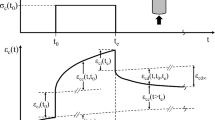Abstract
This paper presents the results of an experimental study on the evaluation of the strains generated in concrete by variations in climatic conditions. In this study, 0.16 m3 concrete blocks, instrumented with vibrating wire extensometers, have been subjected to varied environmental conditioning (drying/wetting) during approximately three years and the strains in the concrete, along with the internal temperatures in the blocks, and the temperatures and relative humidities of the ambient medium, have been recorded. The results of the study show that the strains in the concrete due to environmental effects can reach significant values, which may jeopardize the structural integrity of concrete structures subjected to similar effects and whose boundary conditions cannot accommodate such volume changes. Also, the experimental strains due to drying are compared with those calculated according to the American Concrete Institute (ACI) and Euro-International Committee of Concrete (CEB) recommendations.
Resume
Cet article présente les résultants d'une étude expérimentale qui a trait à l'évaluation des déformations générées dans le béton par des variations de conditions climatiques. L'étude a consisté à soumettre trois blocs de béton, de 0,16 m3 de volume, instrumentés à l'aide d'extensomètres à cordes vibrantes, à un conditionnement environnemental varié (séchage/mouillage) pendant environ trois années et à enregistrer les déformations dans le béton ainsi que les températures intérieures dans les blocs et les températures et humidités relatives du milieu ambiant. Il ressort de l'étude que les déformations dans le béton dues aux effets environnementaux agissant seuls, penvent atteindre des valeurs importantes. Ainsi, une contraction d'environ 400×10−6 m m−1, durant trois années de séchage et une expansion de 250×10−6m m−1 durant deux mois de mouillage ont été enregistrées par example. Ce niveau de déformation peut metre en danger l'intégrité structurale des ouvrages en béton sujets à des effets similarires et dont les conditions aux limites ne peuvent accommoder de tels changements de volume. Une comparaison des déformations expérimentales de retrait du béton avec celles préconisées par l'Institut Américain du Béton (ACI) et par le Comité Euro-International du Béton (CEB) est aussi entreprise dans cette étude.
Similar content being viewed by others
References
Ballivy, G., Benmokrane, B., Poulin, R. and Saleh, K., ‘Une nouvelle technique d'inclusion pour la mesure à long terme des déformations dans des barrages en béton’,Rev. Canadi. Génie Civil 17 (6) (1990) 919–930.
Da Deppo, L. and Datei, C., Time evolution of calibration for electric-acoustic strain metres: experimental research’, in Proceedings of International Conference on Safety of Dams, Coimbra, April 1984 (A. A. Balkema, Cape Town) pp. 195–199.
Bordes, J. L. and Debreville, P. J., ‘Some facts about long-term reliability of vibrating wire instruments’, in Proceedings of National Research Council/Transportation, Research Board Symposium on Reliability of Geotechnical Instrumentation, Washington, DC, 1985.
Shacklock, B. W. and Keene, P. W., ‘The Effect of Mix Proportions and Testing Conditions on Drying Shrinkage and Moisture Movement of Concrete’, Technical Report TRA/266 (Cement and Concrete Association, London, 1957).
Neville, A. M., ‘Properties of Concrete’, 3rd Edn (Pitman, London, 1981) pp. 371–395.
Proceedings of 4th RILEM International Symposium on Creep and Shrinkage of Concrete: Mathematical Modeling, Northwestern University, Evanston, Illinois, August 1986, edited by Bažant, Z. P., p. 909.
Ballivy, G., Benmokrane, B., Saleh, K. and Unembu, D., ‘Instrumentation d'ouvrages souterrains à l'aide d'inclusions de béton instrumentées’, in Proceedings, Congrès International sur les progrès et innovations dans le domaine des travaux souterrains, University of Toronto, September 1989, Vol. 1, pp. 21–30.
ACI Committee 209, ‘Prediction of creep, shrinkage and temperature effects in concrete structures’, in ‘Designing for Creep and Shrinkage in Concrete Structures’, ACI Publication SP-76 (American Concrete Institute, Detroit, 1982) pp. 193–200.
CEB Model Code for Concrete Structures, Comité Euro-International du Béton Bulletin d'Information 124/125E (Fédération internationale de la précontrainte, Paris, 1978).
MacGregor, J. G., ‘Reinforced Concrete Mechanics and Design’ (Prentice-Hall, 1988), pp. 61–68.
Kraai, P. P., ‘Concrete drying shrinkage: facts or fallacies’, in ACI Committee 209, ‘Design for Creep and Shrinkage in Concrete Structures’, ACI Publication SP-76 (American Concrete Institute, Detroit, 1982) pp. 25–51.
Author information
Authors and Affiliations
Rights and permissions
About this article
Cite this article
Benmokrane, B., Ballivy, G., Chaallal, O. et al. Experimental study of the strains generated in concrete by variations in climatic conditions. Materials and Structures 25, 149–156 (1992). https://doi.org/10.1007/BF02472428
Issue Date:
DOI: https://doi.org/10.1007/BF02472428




